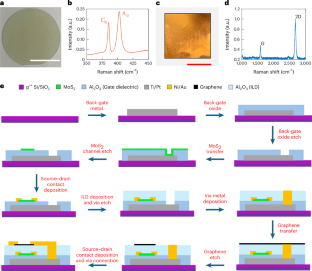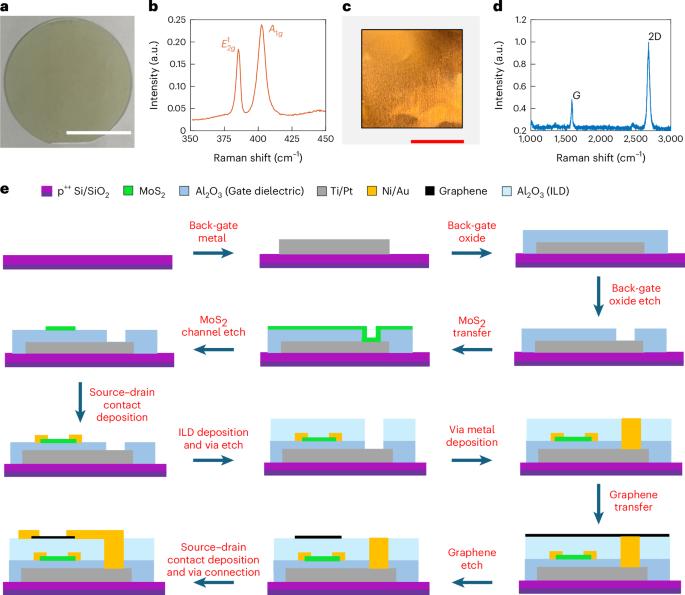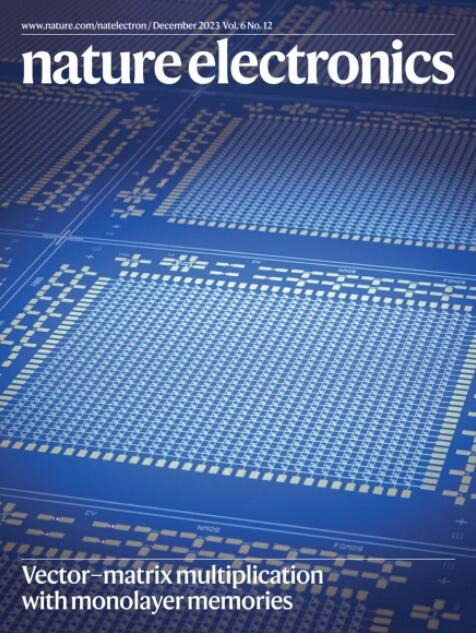Monolithic and heterogeneous three-dimensional integration of two-dimensional materials with high-density vias
IF 33.7
1区 工程技术
Q1 ENGINEERING, ELECTRICAL & ELECTRONIC
引用次数: 0
Abstract
Monolithic three-dimensional (M3D) integration is being increasingly adopted by the semiconductor industry as an alternative to traditional through-silicon via technology as a way to increase the density of stacked, heterogenous electronic components. M3D integration can also provide transistor-level partitioning and material heterogeneity. However, there are few large-area demonstrations of M3D integration using non-silicon materials. Here, we report heterogeneous M3D integration of two-dimensional materials using a dense inter-via structure with an interconnect (I/O) density of 62,500 I/O per mm2. Our M3D stack consists of graphene-based chemisensors in tier 2 and molybdenum disulfide (MoS2) memtransistor-based programmable circuits in tier 1, with more than 500 devices in each tier. Our process allows the physical proximity between sensors and computing elements to be reduced to 50 nm, providing reduced latency in near-sensor computing applications. Our manufacturing process also stays below 200 °C and is thus compatible with back-end-of-line integration. Tiers containing graphene-based sensors and molybdenum disulfide-based processors can be vertically stacked using a monolithic integration process, with an interconnect density of 62,500 per mm2.


二维材料与高密度通孔的单质和异质三维集成
半导体行业正越来越多地采用单片三维(M3D)集成技术来替代传统的硅通孔技术,以提高堆叠式异质电子元件的密度。M3D 集成还能提供晶体管级分区和材料异质性。然而,使用非硅材料进行 M3D 集成的大面积演示还很少。在此,我们报告了二维材料的异构 M3D 集成,采用了密集的孔间结构,互连(I/O)密度为每平方毫米 62,500 I/O。我们的 M3D 堆栈包括第 2 层基于石墨烯的化学传感器和第 1 层基于二硫化钼(MoS2)忆阻器的可编程电路,每层有 500 多个器件。我们的工艺可将传感器与计算元件之间的物理距离缩短至 50 纳米,从而减少近传感器计算应用中的延迟。我们的制造工艺还能保持在 200 °C 以下,因此与后端集成兼容。
本文章由计算机程序翻译,如有差异,请以英文原文为准。
求助全文
约1分钟内获得全文
求助全文
来源期刊

Nature Electronics
Engineering-Electrical and Electronic Engineering
CiteScore
47.50
自引率
2.30%
发文量
159
期刊介绍:
Nature Electronics is a comprehensive journal that publishes both fundamental and applied research in the field of electronics. It encompasses a wide range of topics, including the study of new phenomena and devices, the design and construction of electronic circuits, and the practical applications of electronics. In addition, the journal explores the commercial and industrial aspects of electronics research.
The primary focus of Nature Electronics is on the development of technology and its potential impact on society. The journal incorporates the contributions of scientists, engineers, and industry professionals, offering a platform for their research findings. Moreover, Nature Electronics provides insightful commentary, thorough reviews, and analysis of the key issues that shape the field, as well as the technologies that are reshaping society.
Like all journals within the prestigious Nature brand, Nature Electronics upholds the highest standards of quality. It maintains a dedicated team of professional editors and follows a fair and rigorous peer-review process. The journal also ensures impeccable copy-editing and production, enabling swift publication. Additionally, Nature Electronics prides itself on its editorial independence, ensuring unbiased and impartial reporting.
In summary, Nature Electronics is a leading journal that publishes cutting-edge research in electronics. With its multidisciplinary approach and commitment to excellence, the journal serves as a valuable resource for scientists, engineers, and industry professionals seeking to stay at the forefront of advancements in the field.
 求助内容:
求助内容: 应助结果提醒方式:
应助结果提醒方式:


